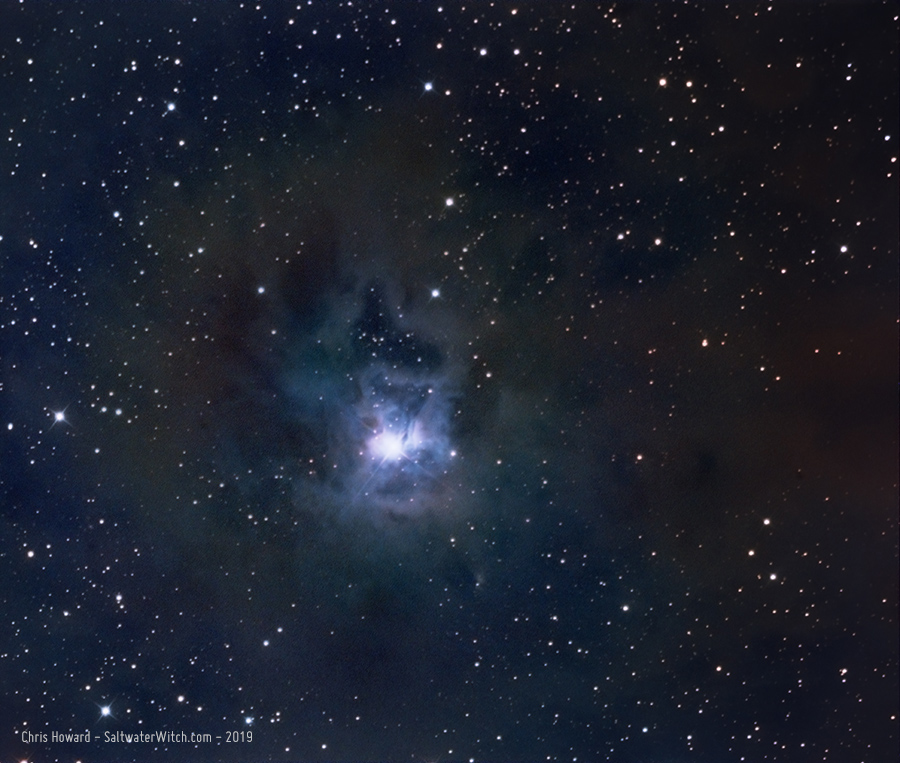Summer nights
I didn't get a chance to set up the scope last night. As soon as the sun went down it clouded over quickly, so I took the Nikon D750 out and captured a few long exposure shots--in the 8 - 20 second range. I managed to get Ursa Major (Big Dipper) between the clouds. That's Polaris (North Star) on the right. And I wasn't alone out there. The fireflies are out, blinking away.

That's Saturn right there low in the sky, right above the path of the fireflies. Even with the clouds, it was a beautiful summer night out there, maybe because the fireflies were adding their bioluminescent fireworks. Here's a 13 second exposure with two of them flying toward each other.
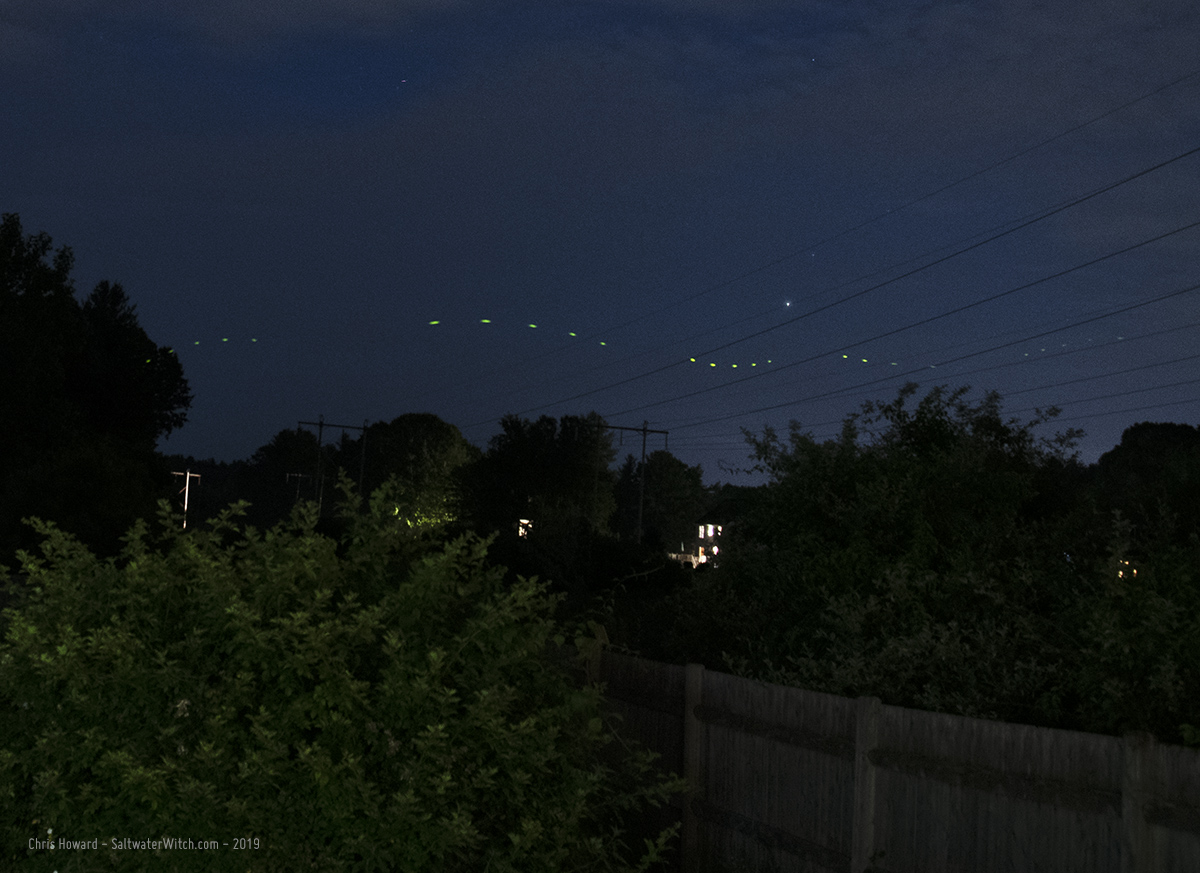
Posted June 29, 2019
Rosette Nebula
The Rosette Nebula (NGC 2237 et. al.) from my backyard. 28 x 240 secs Ha, 26 x 240 secs OIII. William Optics GT81 APO refractor, ZWO ASI1600MM-Pro mono camera, Astronomik filters, iOptron CEM25P mount, INDI/Ekos/KStars

Posted June 27, 2019
AstroTracker Test Shot with the D750
I didn't spend much time on testing last night. The sky was was clear, but seeing was poor. I put the Nikon D750 on the tracker and took a batch of 30 second exposures around 11pm--48 of them, with the tree in the frame. (I cropped some of it out, as well as the edges). Stacked them in DeepSkyStacker and did some processing in PhotoshopCC.
![]()
Here's the test in progress, with the Nikon D750 on the tracker and the electronics--arduino and A4988 controller--on the board below, taken with my iPhone.
![]()
Posted June 23, 2019
AstroTrackerHD v4.2
AstroTrackHD Prototype v4.2 is ready for testing! HD = Harmonic Drive, which is a high-precision, high-torque, zero backlash gear set. See: https://youtu.be/3mWemlMEzFk). The main update with version 4.2 is stepper driver support for interrupt-driven motion, with the ability to set the speed in milliseconds / 1 rotation--"clock mode". This enables me to set the speed equal to one sideral day-with all the gear ratios calculated in. One day in sideral time is 86164.091 seconds, and with a 139:1 ratio gearbox that gives me 619.885 seconds / full rotation. Then on top of this I have the harmonic drive with another 100:1 ratio to calculate in. I'm going to try this out with a camera tonight!
![]()



There's some beautiful weather today, a batch of storm clouds sliding by--north to south--about mile east of us.

Posted June 22, 2019
DIY Power for Astrophotography
 The problem I want to solve is supplying 12v dc power to my astro setups away from mains/grid power, for example, a 110v ac line running from the house. I want enough storage to last a full night with everything--even the big power drains like thermo-electric cooling and dew control covered by the system. Of course there are off-the-shelf solutions for this, but I wanted a little more versatility, a system that I can upgrade, add more batteries if needed, and this is much cheaper than the portable power options out there. It's also specific to my needs: a handful of 12vdc devices, with varying current requirements. (I don't need a built-in flash light or an inverter to power AC devices--things that plug into a wall socket).
The problem I want to solve is supplying 12v dc power to my astro setups away from mains/grid power, for example, a 110v ac line running from the house. I want enough storage to last a full night with everything--even the big power drains like thermo-electric cooling and dew control covered by the system. Of course there are off-the-shelf solutions for this, but I wanted a little more versatility, a system that I can upgrade, add more batteries if needed, and this is much cheaper than the portable power options out there. It's also specific to my needs: a handful of 12vdc devices, with varying current requirements. (I don't need a built-in flash light or an inverter to power AC devices--things that plug into a wall socket).
Here's what I've put together and successfully tested so far:
I bought a small deep-cycle 35 amp-hour lead-acid (AGM) battery, which will get me completely through a night of astro-imaging: through evening setup, an entire night's imaging run with a cooled camera (TEC set to -20C) and dew control running the whole time. In my first tests I discovered I would not go any smaller than the 35Ah @12v dc battery, because I ended the night with it pretty close to completely discharged. Keep in mind the charging cycle with AGMs is a gradual process that uses lower power. Absorbent Glass Mat batteries are safer to use, but require a slower, steadier charging cycle.
Everything I purchased for my power box was perfect except I went underpowered on the charger. The NOCO chargers are awesome (https://no.co). I bought the NOCO Genius G1100 (1.1 amp) and I should have gone with with the G3500 (3.5 amp)--for $20 USD more. The G1100 will charge my NPP NP12-35Ah AGM battery from dead to full in 18 hours. Yeah, see the problem? That's not going to work with more than one clear night in a row. The G3500 will charge the battery in less than 6 hours.
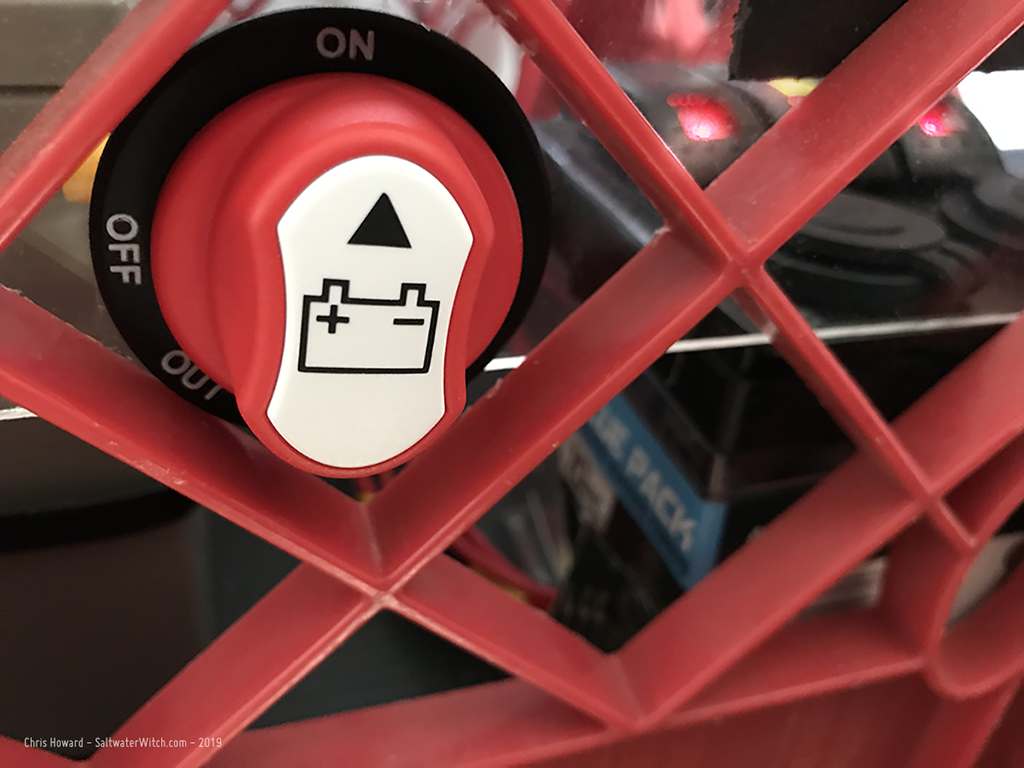 I have everything housed in an old milk crate--an original from the early '80s. But you can buy similar containers today--at Amazon, the Container Store. I attached two pieces of scrap acrylic to two sides. I have my Fanless Windows 10 box secured to one, and I drilled out the other side for my battery power cut-out. I added this so there was no draw on the battery--even minimal. The three switches on the rocker panel are lit when they have power, even when they're off. They have a small LED bar that shows that the switches are functioning, and a brighter red LED when they are powered on. The cut-out also allows me to completely separate the lines running to my gear from the NOCO charging line, if I want to.
I have everything housed in an old milk crate--an original from the early '80s. But you can buy similar containers today--at Amazon, the Container Store. I attached two pieces of scrap acrylic to two sides. I have my Fanless Windows 10 box secured to one, and I drilled out the other side for my battery power cut-out. I added this so there was no draw on the battery--even minimal. The three switches on the rocker panel are lit when they have power, even when they're off. They have a small LED bar that shows that the switches are functioning, and a brighter red LED when they are powered on. The cut-out also allows me to completely separate the lines running to my gear from the NOCO charging line, if I want to.
Tools: wire cutters, wire stripper, soldering iron + solder, and the crimping tool for the connectors (link below)
NOCO chargers https://no.co
NPP NP12-35Ah Rechargeable AGM Deep Cycle 12V 35Ah Battery with Button Style Terminals
https://www.amazon.com/gp/product/B01LW19AOE
Rocker Switch Panel
https://www.amazon.com/gp/product/B075V4CZLF
NOCO GC018 12V Adapter Plug Socket with Eyelet Terminal
https://www.amazon.com/gp/product/B00G8WLW2Y
NOCO Genius G3500 6V/12V 3.5 Amp Battery Charger and Maintainer
https://www.amazon.com/gp/product/B004LWVEKS
Car Battery Switche MAX 50V DC 50A
https://www.amazon.com/gp/product/B01GDYGQJA
Insulated Wire Electrical Connectors Assortment
https://www.amazon.com/dp/B078PMWNJC
Ratcheting Crimper Tool - for the connectors above
https://www.amazon.com/dp/B01IQIALJC
Primary Wire, 14-Gauge Bulk Spool, 100-Feet, Red & Black
https://www.amazon.com/dp/B016TQKT9K
3 x 6ft 2.1mm x 5.5mm Extension Cable, 18AWG for 12V
https://www.amazon.com/dp/B079P842DK
Power Pigtail Cables, 12V 5A Male and Female Connectors
https://www.amazon.com/dp/B07QH8VNY7

Posted June 16, 2019
More from Cygnus: Crescent and Tulip Nebulae
The Crescent Nebula, NGC 6888 (top right) is an emission nebula in the constellation Cygnus, about 5000 light-years away. Like most of this region around Cygnus, you can't do anything in hydrogen-alpha or sulfur2 without wading through clouds of the stuff—billowing, eddying, and general nebulousing. It's beautiful. There's a Wolf-Rayet star, WR 136, at the lower left edge of the Crescent Nebula (from this angle), and it's stirring up violent stellar winds and blazing quickly through its life; it's expected to go supernova in a couple hundred thousand years, and it's only a four or five million years old. WR stars are unusual: they're very bright--thousands of times brighter than our sun, and they burn much hotter, thousands of times hotter than almost all other stars. And they have very short lifespans.
Notes: 31 x 240 sec Ha, 33 x 240 sec OIII, 29 x 240 sec SII, Astronomik Ha, OIII, and SII filters, William Optics GT81 at f/4.7 with WO 0.8x Flat6A II, Moonlite focuser, ZWO ASI120MM OAG, Imaging camera: ZWO ASI1600MM Pro cooled mono on an iOptron CEM25P mount.
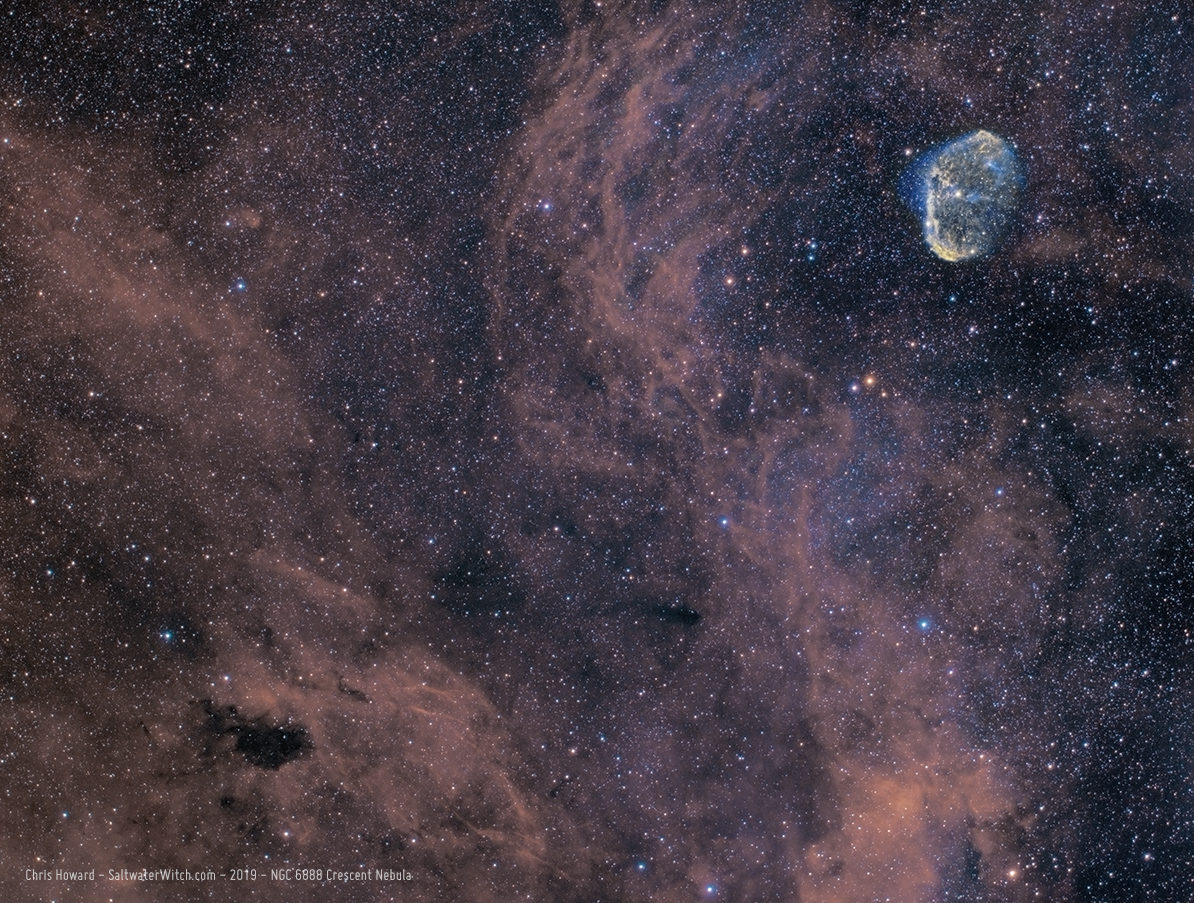
Sharpless 2-101, the Tulip Nebula (top left) is an emission nebula in Cygnus, about 6,000 light-years away. The microquasar Cygnus X-1 is the bright star just above the top point of the Tulip in this image. Cygnus X-1 is famous for being one of the first suspected blackholes, as well as a famous bet between physicists Stephen Hawking and Kip Thorne over that possibility. Hawking conceded to Thorne in 1990 as evidence for a blackhole mounted. Although the Tulip (Sh 2-101) stands out brightly with oxygen in blue, the whole region around the constellation Cygnus is cloudy with interstellar dust and gas. Notes: Astronomik Ha, OIII, and SII filters, William Optics GT81 at f/4.7, ZWO ASI1600MM Pro cooled mono camera, on an iOptron CEM25P mount.

Posted June 12, 2019
North America Nebula (NGC 7000) and the Pelican Nebula (IC 5070, IC 5067)
I spent most of last night's imaging run, about 5.5 hours, on this two-panel mosaic of NGC 7000, the North America Nebula and IC 5070, IC 5067 the Pelican Nebula. NGC7000 and this whole area is one of those deep sky objects with which you can do amazing things in narrowband or broadband color, and turns out beautifully in RGB, bi-color Ha and OIII, even Hydrogen-alpha by itself. For this shot I went with the Hubble Palette in SHO, mapping SII-Ha-OIII to RGB, Sulfur = Red, Hydrogen = Green, Oxygen = Blue. This is why you see aqua and gold standing out in many of the Hubble images. It also affects star color, and you end up with some shade of purple.

Here's an update with the two-panel mosaic of the North America Nebula (NGC 7000) and Pelican Nebula (IC 5070, IC 5068). I fixed the stars and toned down the whole image

Posted June 9, 2019
Broadband color targets - Iris nebula
Yesterday I set up for a couple broadband color targets, and went with the Astro-Tech 6" f/9 Ritchey–Chrétien with 1350mm focal length. I paired the RC with the ZWO ASI071MC cooled color camera. And this is the first time I'll be using the DeepSkyDad Autofocuser AF1, which fits perfectly on the stock Crayford focuser--although you can't see it in this shot because I have the focus knobs vertical on the right site of the scope. Not using an OAG with this setup, but going with the William Optics 200mm guide scope and ZWO ASI120MM-S mono camera.
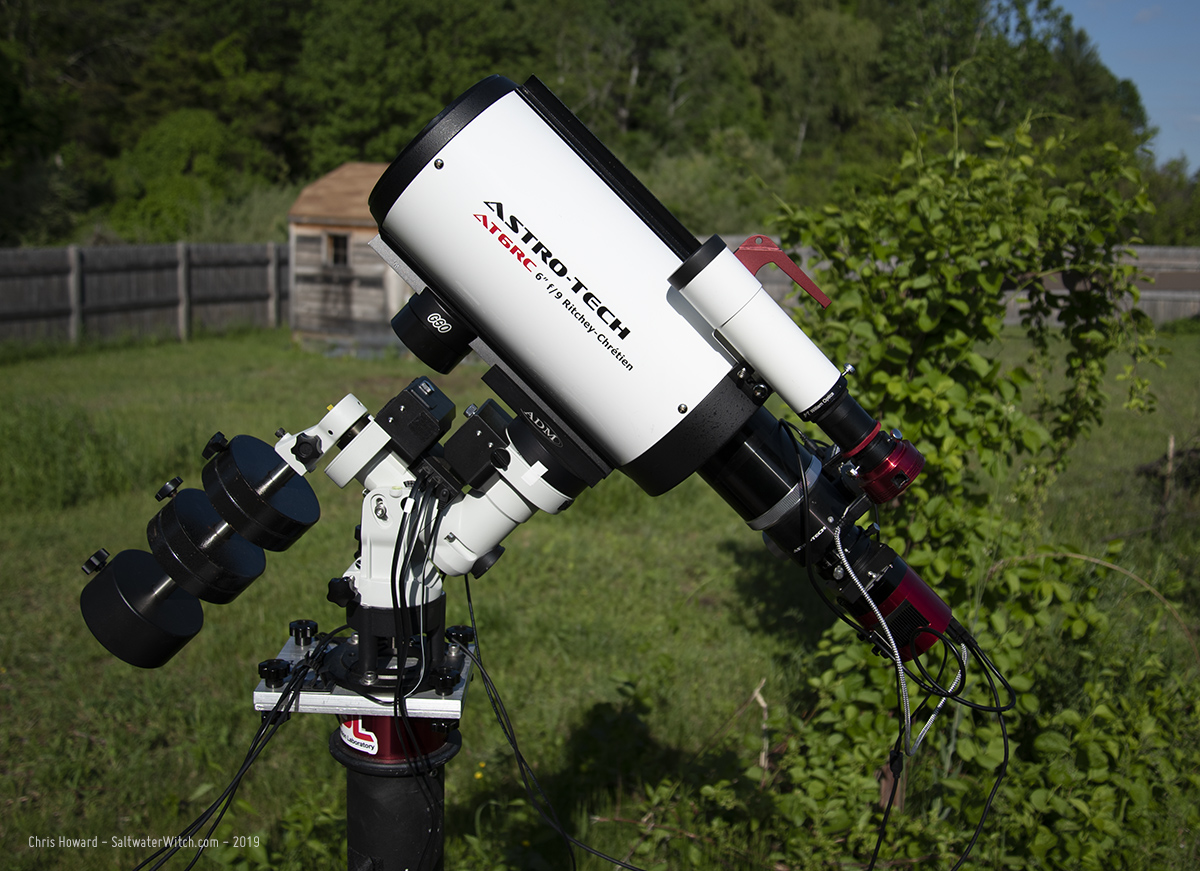
NGC 7023, Iris Nebula is a beautiful reflection nebula in Cepheus, about 1,300 lightyears away.
